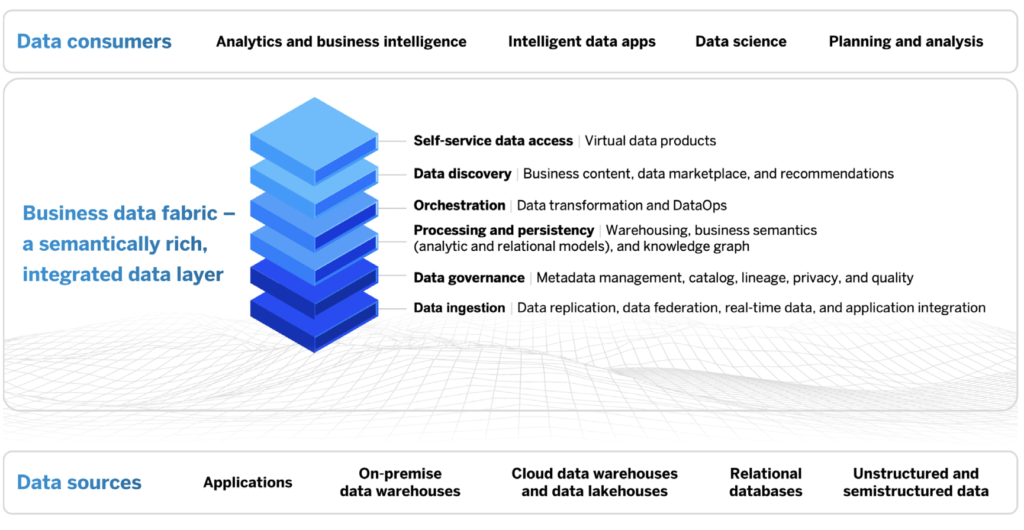Menu
Understand Business Data Fabric Architecture
A Business Data Fabric serves as a dynamic and integrated architecture for managing data, facilitating real-time connectivity across various systems and applications.
- By adopting a technology strategy centred around a Business Data Fabric, your organisation can establish a cohesive and unified perspective of its data landscape.
- This approach play a pivotal role in democratising and automating data management processes, ensuring that stakeholders have access to data whenever and wherever they need it. Particularly beneficial in complex distributed architectures, Business Data Fabric solutions streamline data, transforming it into a readily usable format. This involves unifying, cleansing, enriching, and securing the data, all essential steps in maintaining data integrity and compliance with regulatory standards.
- Unlike traditional data platforms where extracted data often loses its original context, including metadata and business meaning, a Business Data Fabric preserves this context. This preservation ensures that your data remains meaningful and relevant for decision-making, regardless of its source.
- In essence, a Business Data Fabric acts as an integrated layer for consistent data management across multiple systems and applications, offering real-time access and automation capabilities. Enhancing this data architecture, a Business Data Fabric retains crucial business logic and context within the data. This retention ensures a comprehensive and reliable view, enabling faster and more informed decision-making.
- By maintaining the business context of data, a Business Data Fabric reduces the need to re-establish lost information due to extraction and replication processes. This ensures that stakeholders and data consumers have swift and trusted access to comprehensive data, regardless of its storage location or design.

01
Data Integration
Integration serves as a crucial link, connecting diverse data storage systems like databases, applications, and sensors to a centralised hub. This facilitates the analysis of disparate datasets from a unified perspective.
03
Processing-Semantics - Knowledge Graph
This layer establishes a shared description of content across different systems to narrate the data story. It accomplishes this through a model outlining data and metadata, complemented by a semantic layer that encapsulates established business terms. A business data fabric can seamlessly model semantics from the source of operational data to advanced analytics and data science.
05
Data Management Automation
Automation serves as a pivotal architectural feature, efficiently and consistently managing data. It reduces errors, saves time, and enhances data quality by automating tasks such as integration, governance, and security.
02
Real-Time Data Governance
A business data fabric offers instantaneous access to live operational data, eliminating the need for time-consuming and error-prone extraction processes. It ensures that data is well-organised, secure, and of high quality, encompassing tasks such as data integration, governance, and security.
04
Data Transformation and Orchestration
This phase involves the processing and analysis of data to extract insights. It encompasses tasks like data warehousing, streaming, and visualisation. Additionally, a business data fabric harnesses predictive analytics, AI, and text analytics on operational data, enriching decision-making and enabling adaptive, self-learning business processes.
06
Self Service Data Access
A business data fabric doesn't confine users to a single tool set. Instead, it allows for expansion by integrating cutting-edge solutions and services from leading vendors, augmenting capabilities like governance or advanced machine learning.
Each of these components operates in unison to deliver the robust advantages of a business data fabric. Together, they create an environment where data flows seamlessly, is comprehensively understood, and informs the most intelligent and relevant business decisions.
Glynn Williams
Data | Integration | Analytical Services
How Emphasys helps you with a Business Data Fabric
Data Ingestion
The initial phase in constructing a business data fabric revolves around ensuring seamless ingestion of all data, structured or unstructured, into the system. Emphasys helps you leverage your new business data fabric which simplifies data ingestion, accommodating diverse data sources and formats effortlessly.
Data Integration
Harmonising data from various origins necessitates its integration and transformation into a unified format readily accessible to data users. The interoperability inherent in a business data fabric facilitates the consolidation and linkage of data from disparate sources, transcending mere data movement. Emphasys helps you integrate your diverse data sources into SAP Datasphere.
Data Consumption
Ultimately, the focus shifts to delivering pertinent data in the appropriate format, at the right time, and to the relevant stakeholders. Through data federation, the business data fabric facilitates unified and consistent data access across diverse sources, mitigating redundancy. Emphasys helps ensure data is presented in business-friendly terms and contexts, using SAP Analytics Cloud, facilitating its interpretation and utilisation for specific use cases by data consumers.


